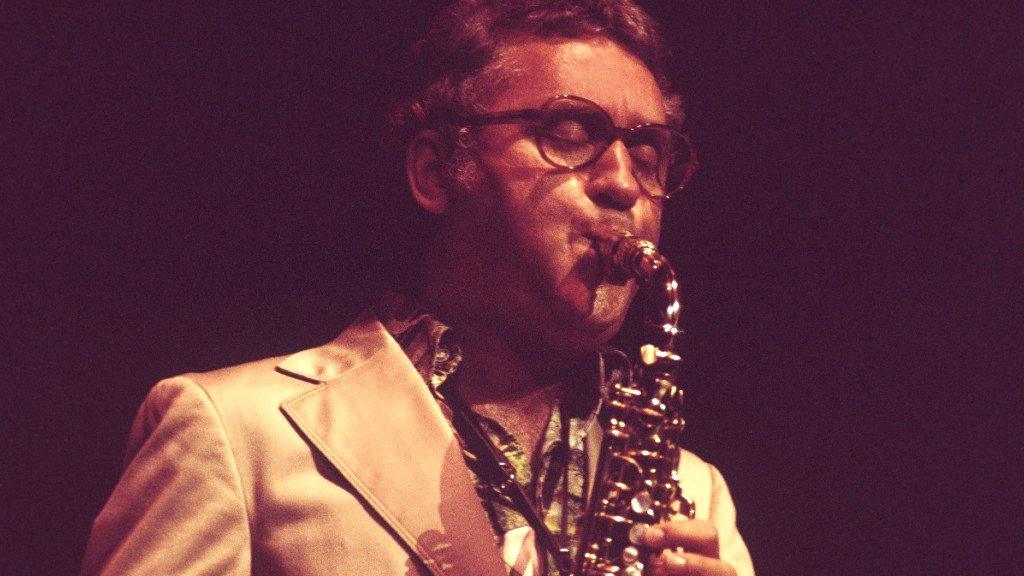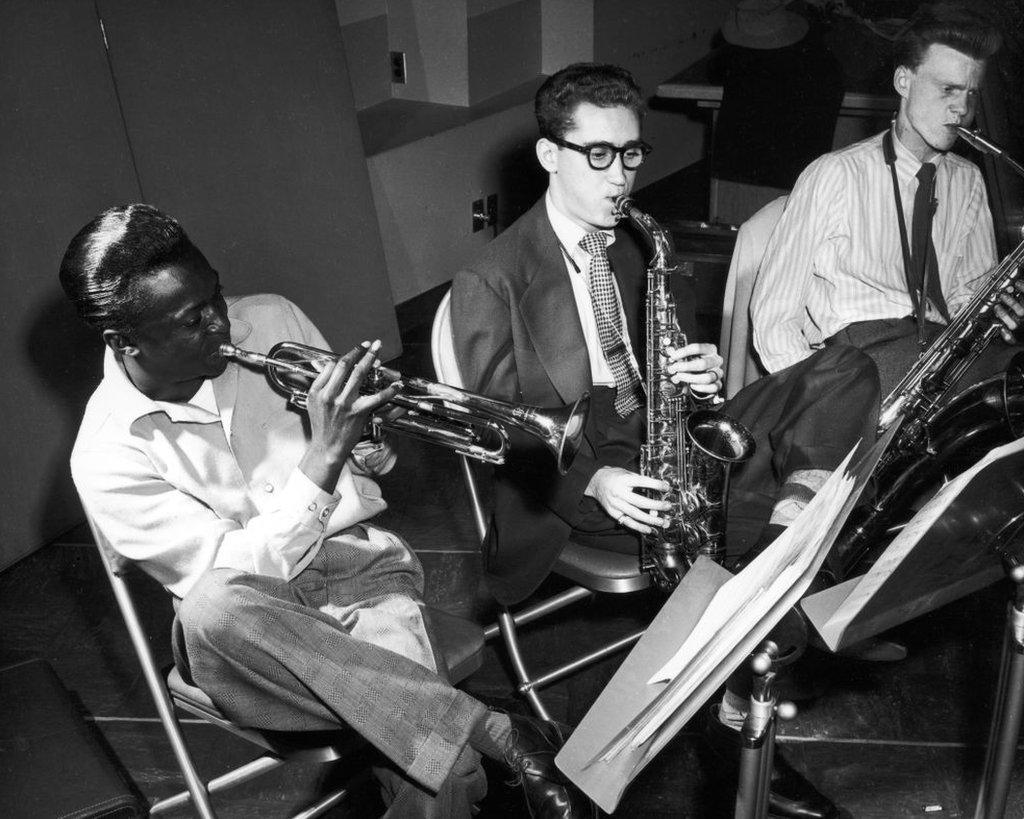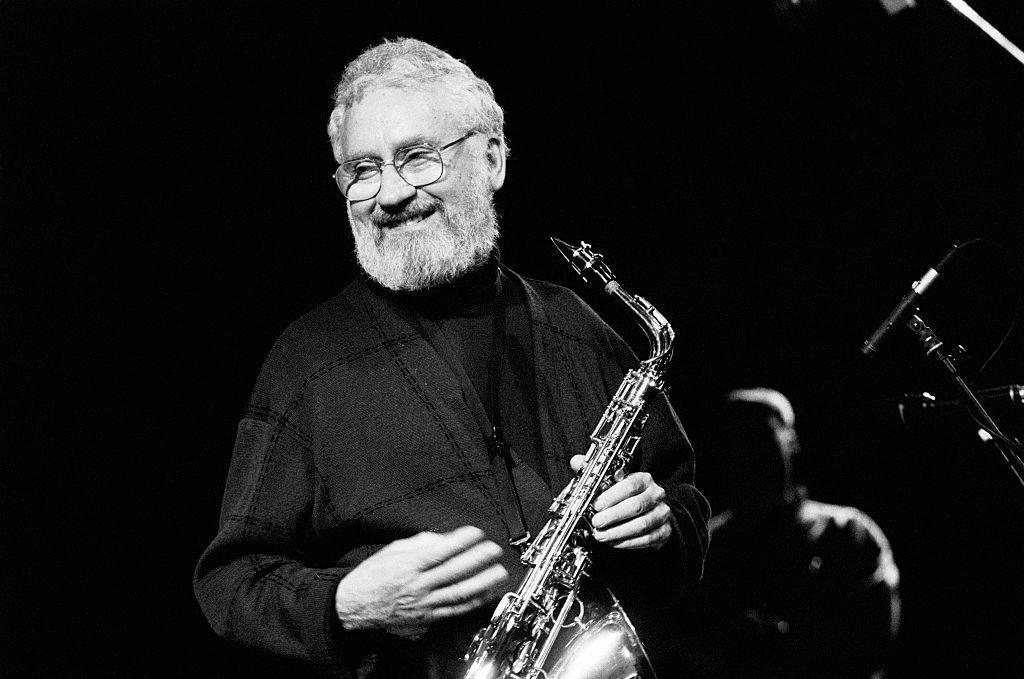Lee Konitz: Jazz saxophonist dies with coronavirus
- Published

The musician's improvisational style influenced generations of musicians
Celebrated jazz musician Lee Konitz has died at the age of 92 after contracting Covid-19.
The saxophonist, who was known for his ground-breaking improvisational style, played with greats like Charles Mingus, Bud Powell and Ornette Coleman.
But he was perhaps best known as one of the musicians on Miles Davis's landmark album Birth Of The Cool.
His family confirmed to NPR, external he had died in New York from pneumonia related to the coronavirus.
Born 1927 in Chicago, Konitz studied clarinet early on, then switched to the alto saxophone, developing an individual style characterised by a willingness to take daring harmonic risks.
His uninflected tone set him apart from the dominant style of the 1950s, established by Charlie Parker - who he counted as a close friend.
"I knew and loved Charlie Parker and copied his bebop solos like everyone else," Konitz told The Wall Street Journal in 2013, external.
"But I didn't want to sound like him. So I used almost no vibrato and played mostly in the higher register. That's the heart of my sound."

Lee (centre) in the studio with Miles Davis (left) and Gerry Mulligan (right)
He developed his passion for improvisation as a teenager, when he spent three years studying and playing with the blind pianist Lennie Tristano.
"The idea is that the music is full of surprises," he said.
"Improvisary means unforeheard, unforeseen. I don't know what the Latin word for heard is. But it's something like that."
Audacious
In 1949, he recorded what are considered to be the first two freely improvised jazz records - Intuition and Digression - with the Lennie Tristano quintet.
The concept was that the musicians knew which order they'd join the ensemble playing, but nothing else was predetermined -from key and tempo to melody and rhythm.
Critic Barry Ulanov called it "the most audacious experiment yet attempted in jazz".
In the same year, he played with Miles Davis on the sessions that were eventually compiled to form the seminal Birth Of The Cool album, which spawned the "cool jazz" sound of the 50s.
Allow YouTube content?
This article contains content provided by Google YouTube. We ask for your permission before anything is loaded, as they may be using cookies and other technologies. You may want to read Google’s cookie policy, external and privacy policy, external before accepting. To view this content choose ‘accept and continue’.
But critical acclaim did not translate into work, and Konitz briefly left music behind in the 1960s, before a renaissance in New York's jazz scene tempted him back onto the stage.
Over the course of his career, he recorded dozens of albums ranging in style from Dixieland to bop and thoughtful improvisation.
His 1967 recording Duets, which saw him spar with musicians like guitarist Jim Hall and tenor saxophonist Joe Henderson is considered one of the best examples of his "acerbic wit and quick mind," according to critic Jack Fuller, external.
He also played unaccompanied on 1974's Lone-Lee, and dabbled in classical music on 2000's French Impressionist Music from the Turn of the Twentieth Century.
Konitz himself wrote little original music, and most of his recordings were contrafacts - melodies based on existing chord changes. His best-known piece, Subconscious-Lee, was an improvisation on Cole Porter's What Is This Thing Called Love.
Allow YouTube content?
This article contains content provided by Google YouTube. We ask for your permission before anything is loaded, as they may be using cookies and other technologies. You may want to read Google’s cookie policy, external and privacy policy, external before accepting. To view this content choose ‘accept and continue’.
"That's a technique I just picked up along the way from whoever invented it, whether it was Bird [Charlie Parker] or whoever," he told Downbeat in 2017, external.
"I consider it equivalent in some way to adding homemade lyrics to a melody that you could deliver the standard changes on. But then you change them somehow. And that's kind of how I approach that."

The musician had a strong musical curiosity, and played with dozens of other artists
The musician had heart issues later in life but continued to tour and play into his 90s.
His most recent album was Old Songs New (Sunnyside) - recorded when he was 90 and released last November.
Among the many trophies he received for his talents, Konitz won the NEA Jazz Masters Award in 2009 and was named Alto Saxophonist of the Year by the Downbeat Magazine Critics Poll in 2010.
The musician was married three times and is survived by two sons, Josh and Paul; three daughters, Rebecca Pita, Stephanie Stonefifer and Karen Kaley; three grandchildren and one great-granddaughter.

A SIMPLE GUIDE: How do I protect myself?
AVOIDING CONTACT: The rules on self-isolation and exercise
HOPE AND LOSS: Your coronavirus stories

Follow us on Facebook, external, or on Twitter @BBCNewsEnts, external. If you have a story suggestion email entertainment.news@bbc.co.uk, external.